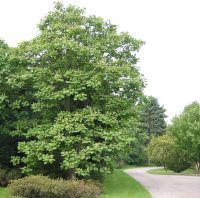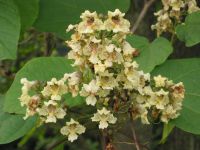Yellow Catalpa, Chinese catalpa - Catalpa ovata
English name:
Yellow Catalpa, Chinese catalpa
Scientific name:
Catalpa ovata
Family:
Bignoniaceae (Bignonia, or Trumpet-creeper)
Height:
10 M in Denmark
Flowering:
First half of august
Range:
China
 |
|
 |
 |
The 55 year old Catalpa ovata in the top picture is from seed received from Arnold Arboretum, in Massachusetts, USA. The plant can be found at the corner of the north side of the first grass plain and the main road after one enters the main gate of the arboretum: square 1115, position 1939.
Plant description:
The genus Catalpa contains 10 species, two from North America and the rest from eastern Asia. The name, "Catalpa" is derived from a transcription error of the North American Indian name, Catawba, when the first scientific description was made. The leaves are large and leaf margins lack teeth in this genus, although triangular, pointed lobes may be present. Leaves are opposite or arranged in whorls of three. They are thin making them easily damaged in exposed conditions. The shoots form no terminal buds, which results in a wide-crowned deciduous trees when open grown. Some species of Catalpa are reported to produce allelopathic chemicals that inhibit the growth or germination of other plants. But this only appears to be a problem when they are grown in stands. We have 3 species of Catalpa in our collection and 9 specimens of Catalpa ovata. Most are rather young specimens, under 4 m tall. But several of these are flowering even though they are less than 11 years old from seed.
Catalpa ovata also goes under the name Catalpa kaempferi. It is reported to have been grown in Krenkerup garden in 1872. Our oldest living specimen is from 1950. This species is almost only found in botanical collections in Denmark. It is resistant to air pollution and has been planted for several centuries in Japan as a garden tree. It is attractive to bees when in flower. It is reported to absorb both lead and cadmium pollution from the air. There are many studies of the chemical substances found naturally in this tree which is used in Chinese medicine.
When young and established these are vigorous, deciduous trees. The leaves occur in whorls of three or in pairs along the shoots. They are pentagonal in outline because of the three to 5 pointed lobes. They are large, 12-25 cm long and wide. The veins on the upper surface are reddish purple with short hairs. The vein axils have purple spots with sticky glands. The leaf stalk is round, reddish on top like the leaf veins. Leafing out is very late compared with other trees, so visitors often ask if the tree is dead. Shoots are green or brownish green with sparse stiff hairs and become dark brown. The flowers are in terminal panicles composed of many tubular yellowish-white flowers with purple dots. The fruit is a slim hanging pod about 30 cm in length and remind one of a vanilla pod, or a very slim bean pod. While pods form on our oldest tree, I have not seen filled seed.
While needing shelter from strong winds this pollution-tolerant tree might be rather good for large parks, especially considering their late flowering. It is resistant to honey fungus and is reported to be one of the best bee trees in Japan. They are recommended to be open-grown so one can admire their flowering up close. The flowers are not as large as in the other species for example Catalpa speciosa, but we have been more successful in growing this species at the Arboretum. Catalpas are reported to be messy, dropping twigs and fruit.
